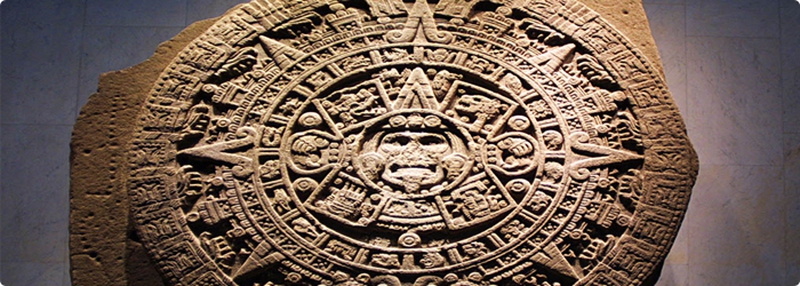The calendar dates back to at least the 5th century BC and is still in use in a few Mayan communities today.
The Mayan calendar moves in cycles with the last cycle ending in December 2012. This has often been interpreted as "the world will end" on 21 December 2012, at 11:11 UTC.
The last day of the Mayan calendar corresponds with the Winter Solstice (or December Solstice), which has played a significant role in many cultures all over the world.
The Maya didn't invent the calendar, it was used by most cultures in pre-Columbian Central America – including the Maya – from around 2000 BC to the 16th century. The Mayan civilization developed the calendar further and it's still in use in some Maya communities today.

Part 1
Wheels working together
The Mayan Calendar consists of three separate corresponding calendars, the Long Count, the Tzolkin (divine calendar) and the Haab (civil calendar). Time is cyclical in the calendars and a set number of days must occur before a new cycle can begin.
The three calendars are used simultaneously. The Tzolkin and the Haab identify and name the days, but not the years. The Long Count date comes first, then the Tzolkin date and last the Haab date. A typical Mayan date would read: 13.0.0.0.0 4 Ahau 8 Kumku, where 13.0.0.0.0 is the Long Count date, 4 Ahau is the Tzolkin date and 8 Kumku is the Haab date.
The Haab
The Haab is a 365 day solar calendar which is divided into 18 months of 20 days each and one month which is only 5 days long (Uayeb). The calendar has an outer ring of Mayan glyphs (pictures) which represent each of the 19 months. Each day is represented by a number in the month followed by the name of the month. Each glyph represents a personality associated with the month.
The Haab is somewhat inaccurate as it is exactly 365 days long. An actual tropical or solar year is 365.2422 days long. In today’s Gregorian calendar we adjust for this discrepancy by making almost every fourth year a leap year by adding an extra day – a leap day – on the 29th of February.
The Tzolkin
The divine calendar is also known as the Sacred Round or the Tzolkin which means “the distribution of the days”. It is a 260-day calendar, with 20 periods of 13 days used to determine the time of religious and ceremonial events. Each day is numbered from one to thirteen, and then repeated. The day is also given a name (glyph) from a sequence of 20 day names. The calendar repeats itself after each cycle.
The Long Count
The Long Count is an astronomical calendar which was used to track longer periods of time, what the Maya called the “universal cycle”. Each such cycle is calculated to be 2,880,000 days (about 7885 solar years). The Mayans believed that the universe is destroyed and then recreated at the start of each universal cycle. This belief still inspires a myriad of prophesies about the end of the world.
The “creation date” for the current cycle we are in today, is 4 Ahaw, 8 Kumku. According to the most common conversion, this date is equivalent to August 11, 3114 BC in the Gregorian calendar or September 6 in the Julian calendar.
How to set the date
A date in the Maya calendar is specified by its position in both the Tzolkin and the Haab calendars which aligns the Sacred Round with the Vague Year creating the joint cycle called the Calendar Round, represented by two wheels rotating in different directions. The Calendar round cycle takes approximately 52 years to complete.
The smallest wheel consists of 260 teeth with each one having the name of the days of the Tzolkin. The larger wheel consists of 365 teeth and has the name of each of the positions of the Haab year. As both wheels rotate, the name of the Tzolkin day corresponds to each Haab position.
The date is identified by counting the number of days from the “creation date”.
A typical long count date has the following format: Baktun.Katun.Tun.Uinal.Kin.
Kin = 1 Day.
Uinal = 20 kin = 20 days.
Tun = 18 uinal = 360 days.
Katun = 20 tun = 360 uinal = 7,200 days.
Baktun = 20 katun = 400 tun = 7,200 uinal = 144,000 days.
The kin, tun and katun are numbered from zero to 19; the uinal are numbered from zero to 17; and the baktun are numbered from one to 13. The Long Count has a cycle of 13 baktuns, which will be completed 1.872.000 days (13 baktuns) after 0.0.0.0.0. This period equals 5125.36 years and is referred to as the “Great Cycle” of the Long Count.
View All Comments /Add Comment